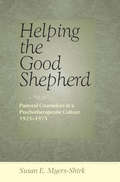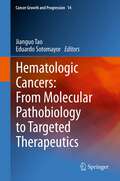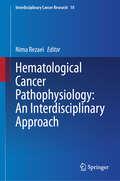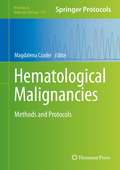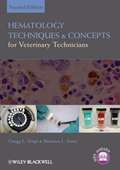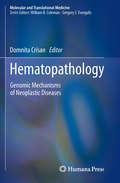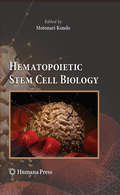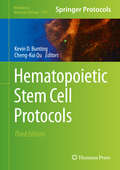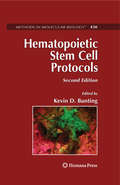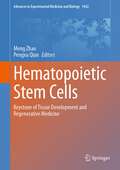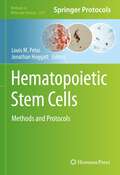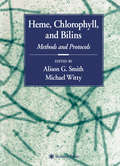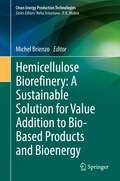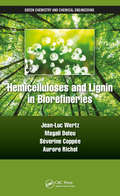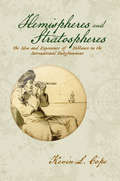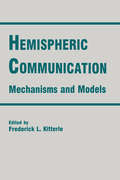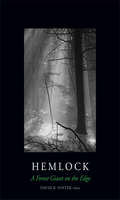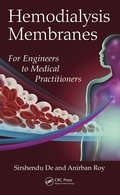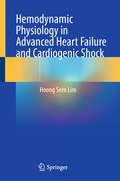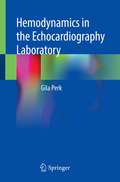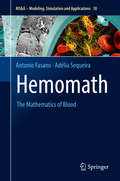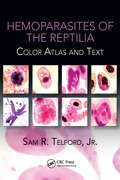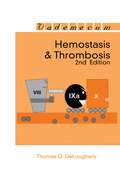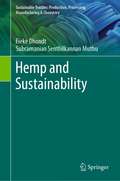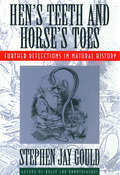- Table View
- List View
Helping the Good Shepherd: Pastoral Counselors in a Psychotherapeutic Culture, 1925–1975 (Medicine, Science, and Religion in Historical Context)
by Susan E. Myers-ShirkThis history of Protestant pastoral counseling in America examines the role of pastoral counselors in the construction and articulation of a liberal moral sensibility. Analyzing the relationship between religion and science in the twentieth century, Susan E. Myers-Shirk locates this sensibility in the counselors’ intellectual engagement with the psychological sciences. Informed by the principles of psychology and psychoanalysis, pastoral counselors sought a middle ground between science and Christianity in advising anxious parishioners who sought their help for personal problems such as troubled children, violent spouses, and alcohol and drug abuse. Myers-Shirk finds that gender relations account in part for the great divide between the liberal and conservative moral sensibilities in pastoral counseling. She demonstrates that, as some pastoral counselors began to advocate women’s equality, conservative Christian counselors emerged, denouncing more liberal pastoral counselors and secular psychologists for disregarding biblical teachings. From there, the two sides diverged dramatically. Helping the Good Shepherd will appeal to scholars of American religious history, the history of psychology, gender studies, and American history. For those practicing and teaching pastoral counseling, it offers historical insights into the field.
Hematologic Cancers: From Molecular Pathobiology to Targeted Therapeutics
by Eduardo Sotomayor Jianguo TaoIn the last decade, there has been a remarkable explosion of knowledge in hematologic cancer from basic molecular biology and pathology to clinical therapy. This has led to many new advance and insights in the understanding of pathobiology of malignant hematology. New knowledge of disease molecular pathology, cytogenetic, epigenetic and genomic alterations have provided new strategies to attack and eradicate tumor cells at molecular level and significantly impacted our current therapeutics for hematological malignancies. The recent and ongoing rapid expansion of knowledge in this area has become extensive, dynamic and diffuse over the literature and research publications. This has led to the need to capture and compile the new and current information about hematologic cancer with special emphasis on translation from molecular pathobiology to targeted therapeutics. In this book experts from around the world share their thoughts and knowledge about the pathobiology of hematologic cancer, as well as their view on current treatment approaches and future development in these malignant hematologic diseases. This book is well suited for hematology residents, fellows and hematology-oncology physicians, hematopathologist as well as basic research scientist in the area of hematologic malignancies.
Hematological Cancer Pathophysiology: An Interdisciplinary Approach (Interdisciplinary Cancer Research #10)
by Nima RezaeiHematological cancers or blood cancers are a heterogeneous group of malignant neoplasms, including leukemia, lymphoma, and myeloma, primarily affect the blood and bone marrow. The “Hematological Cancer Pathophysiology: An Interdisciplinary Approach” is the tenth volume of the “Interdisciplinary Cancer Research” series, publishes a comprehensive volume on the pathophysiology of hematological cancers. This volume has an interdisciplinary approach in hematological cancers, including myeloproliferative neoplasms, T-cell lymphoma, Hodgkin's lymphoma, non-Hodgkin's lymphoma, and intraocular lymphoma. Waldenstrom macroglobulinemia and IgG4-related diseases are also discussed in the last chapters. This interdisciplinary series is of special value to researchers working on hematology and oncology. This is the main concept of Cancer Immunology Project (CIP), which is a part of Universal Scientific Education and Research Network (USERN). This interdisciplinary book will be of special value to hematologists and oncologists who wish to extend their knowledge on hematological cancers.
Hematological Malignancies
by Magdalena CzaderIncreased knowledge on the pathogenesis of hematologic diseases has been translated into diagnostic and prognostic applications. Hematopathology and laboratory hematology were among the first disciplines to embrace molecular diagnostics. Hematological Malignancies:Methods and Protocols, explores molecular-based assays frequently used in the routine diagnostic hematopathology and laboratory hematology. Many of these protocols were initially developed as research applications and were further refined as they transitioned to the diagnostic laboratory. Written in the highly successful Methods in Molecular BiologyTM series format, chapters include introductions to their respective topics, lists of the necessary materials and reagents, step-by-step, readily reproducible laboratory protocols, and key tips on troubleshooting and avoiding known pitfalls. Authoritative and practical, Hematological Malignancies: Methods and Protocols aids scientist in the continuing study of tests essential for contemporary laboratory diagnostics of hematological neoplasms.
Hematology Techniques and Concepts for Veterinary Technicians (2nd edition)
by Gregg L. Voigt Shannon L. SwistThe major reason for the preparation of this second edition is to introduce the veterinary technology student to new technology, equipment, and test techniques that are becoming more available in the field of veterinary hematology. The intent of the new edition remains the same as in the previous edition. It is an introductory overview of veterinary hematology and a guide for the student to learn the fundamental concepts of collecting, handling, preparing, and testing blood and other samples in the hematology laboratory. It is not intended as a diagnostic aid, differential disease discussion, or complete atlas of blood cells.
Hematopathology
by Domnita CrisanHematopathology: Genomic Mechanisms of Neoplastic Diseases will keep physicians abreast of the rapid and complex changes in genomic medicine, as exemplified by the molecular pathology of hematologic malignancies. This timely volume will update physicians on the complexities of genomic lesions, as well as offer an integrated framework encompassing molecular diagnosis, the new WHO classification of hematologic neoplasms with focus on molecular pathology, prognostic value of molecular tests, and molecular monitoring of response to gene-targeted therapy. As such, it will be of great value to hematologists, oncologists, pathologists, internal medicine and pediatric specialists, as well as bioscientific staff and laboratorians in private hospitals and academic institutions.
Hematopoietic Stem Cell Biology
by Motonari KondoThis book is written by experts in the field of hematopoietic stem cell biology and lymphocyte development in order to overview recent advances in the field. Prospective isolation of various progenitors and stem cells enables us to understand self-renewal mechanisms of stem cells as well as regulation of hematopoiesis. Furthermore, the importance of extrinsic factors has been emphasized recently. This volume concisely describes our current understanding of normal hemato/lymphopoiesis as well as abnormal hematopoiesis, which may lead to leukemia.
Hematopoietic Stem Cell Protocols
by Kevin D. Bunting Cheng-Kui QuUpdating and building upon previous editions, Hematopoietic Stem Cell Protocols, Third Edition provides up-to-date protocols from leading stem cell researchers. This in-depth volume presents a clear view of the landscape of assays available to the stem cell researcher working in the growing hematopoietic stem cell (HSC) field. A robust and active field, it is supported by an abundance of innovative mouse models and molecular tools for analysis of phenotypes and functions in mouse and human cells. Understanding more about hematopoietic stem cell biology is integral if these versatile cells are to be applied effectively to treat and cure a wide range of blood diseases An introductory chapter puts the major contributions of the book into the proper perspective. Written in the successful Methods in Molecular Biology series format, chapters include introductions to their respective topics, lists of the necessary materials and reagents, step-by-step, readily reproducible protocols, and notes on troubleshooting and avoiding known pitfalls. Essential for the laboratory-based researcher, Hematopoietic Stem Cell Protocols, Third Edition is a much needed technical resource in the critically important field of hematopoietic stem cell investigation.
Hematopoietic Stem Cell Protocols
by Kevin D. BuntingThis revised edition provides up-to-date protocols developed in the HSC field. A team of leading researchers supply this volume with in-depth, readily reproducible methods for effective characterization of HSC and their developmental potential. The book provides detailed flow cytometry protocols for thorough analysis of enriched HSC populations, and offers a variety of transplantation approaches to measure HSC function in vivo. This is a much needed technical resource in the critically important field of stem cell investigation.
Hematopoietic Stem Cells: Keystone of Tissue Development and Regenerative Medicine (Advances in Experimental Medicine and Biology #1442)
by Meng Zhao Pengxu QianThis book renders a comprehensive understanding of hematopoietic stem cells (HSCs) from their embryonic development through adult maintenance to aging, in the studies conducted in zebrafish and mammals. Hematopoiesis provides a paradigm for understanding the development, maintenance, regeneration, aging and malignant transformation of mammalian organs. Sitting at the apex of the hematopoiesis hierarchy tree, HSCs orchestrate their proliferation, self-renewal, and differentiation to produce all the blood cell lineages throughout life, which represents the best example for somatic stem cell studies. In this book, key regulatory mechanisms for HSC self-renewal and differentiation are overviewed in an array of fields including epigenetics, metabolism and microenvironment regulation. It also highlights the HSC heterogeneity and clonal dynamics from the recent advanced single-cell technologies. This book elaborates on the research history of HSC studies and reveals how the insights from HSC studies shed light on their clinic application. It presents great value from the bench to the clinic.
Hematopoietic Stem Cells: Methods and Protocols (Methods in Molecular Biology #2567)
by Louis M. Pelus Jonathan HoggattThis detailed volume collects updates on the technical advances in hematopoietic stem cell research and incorporates new techniques focused on the molecular/genetic, cellular, and whole organism levels. Exploring methods that apply stress to hematopoiesis, the book also contains chapters focused on better understanding the role of hematopoietic niches and their cellular components, as well as in vivo models that test and quantitate stem cell function and are key to further development of therapeutic applications. Written for the highly successful Methods in Molecular Biology series, chapters include introductions to their respective topics, lists of the necessary materials and reagents, step-by-step and readily reproducible laboratory protocols, and tips on troubleshooting and avoiding known pitfalls. Authoritative and up-to-date, Hematopoietic Stem Cells: Methods and Protocols serves as a valued addition to laboratories focused on understanding hematopoietic stem cell biology and the therapeutic advances that can be derived from it.
Heme, Chlorophyll, and Bilins
by Alison Smith Michael WittyIn Heme, Chlorophyll, and Bilins: Methods and Protocols, an interdisciplinary panel of hands-on investigators describe in detail how to work successfully with chlorophyll, heme, and bilins in biological, medical, chemical, and biochemical research. Each method is presented by a researcher who actually uses it on a daily basis and includes step-by-step instructions and pertinent tricks-of-the-trade that often make the difference between laboratory success and failure. Topics range from methods for the analysis of tetrapyrroles,heme, and hemoproteins, to the biosynthesis and analysis of chlorophyll and bilins.
Hemicellulose Biorefinery: A Sustainable Solution for Value Addition to Bio-Based Products and Bioenergy (Clean Energy Production Technologies)
by Michel BrienzoThis edited book provides knowledge about hemicelluloses biorefinery approaching production life cycle, circular economy, and valorization by obtaining value-added bioproducts and bioenergy. A special focus is dedicated to chemical and biochemical compounds produced from the hemicelluloses derivatives platform. Hemicelluloses are polysaccharides located into plant cell wall, with diverse chemical structures and properties. It is the second most spread organic polymer on nature and found in vast lignocellulosic materials from agro and industrial wastes, therefore, hemicelluloses are considered as abundant and renewable raw material/feedstock. Biorefinery concept contributes to hemicelluloses production associated with biomass industrial processes. Hemicelluloses are alternative sources of sugars for renewable fuels and as platform for chemicals production. This book reviews chemical processes for sugar production and degradation, obtaining of intermediate and final products, and challenges for pentose fermentation. Aspects of hemicelluloses chain chemical and enzymatic modifications are presented with focus on physicochemical properties improvement for bioplastic and biomaterial approaches. Hemicelluloses are presented as sources for advanced materials in biomedical and pharmaceutical uses, and as hydrogel for chemical and medicine deliveries. An interdisciplinary approach is needed to cover all the processes involving hemicelluloses, its conversion into final and intermediate value-added compounds, and bioenergy production. Covering this context, this book is of interest to teachers, students, researchers, and scientists dedicated to biomass valorization. This book is a knowledge source of basic aspects to advanced processing and application for graduate students, particularly. Besides, the book serves as additional reading material for undergraduate students (from different courses) with a deep interest in biomass and waste conversion, valorization, and chemical products from hemicelluloses
Hemicelluloses and Lignin in Biorefineries (Green Chemistry and Chemical Engineering)
by Jean-Luc Wertz Magali Deleu Séverine Coppée Aurore RichelHemicelluloses and Lignin in Biorefineries provides an understanding of lignocellulosic biomass, which is mainly composed of cellulose, hemicelluloses, and lignin. It promotes the valorization of these molecules in the context of the bioeconomy and presents hemicelluloses and lignin, which are generated in lignocellulosic biorefineries, as the molecules of the future. The viability of these molecules lies in their renewability and potential. This book covers all aspects of hemicelluloses and lignin including structure, biosynthesis, extraction, biodegradation, and conversion. The book also looks ahead to the socioeconomic and environmental value of biobased industry and emphasizes an understanding of the potential of lignocellulosic biomass.
Hemispheres and Stratospheres: The Idea and Experience of Distance in the International Enlightenment (Transits: Literature, Thought & Culture 1650-1850)
by Rachel Mann Phyllis Thompson Kevin L. Cope Roger D. Lund William Stargard Bärbel Czennia Brijraj Singh Chandrava ChakravartyRecognizing distance as a central concern of the Enlightenment, this volume offers eight essays on distance in art and literature; on cultural transmission and exchange over distance; and on distance as a topic in science, a theme in literature, and a central issue in modern research methods. Through studies of landscape gardens, architecture, imaginary voyages, transcontinental philosophical exchange, and cosmological poetry, Hemispheres and Stratospheres unfurls the early history of a distance culture that influences our own era of global information exchange, long-haul flights, colossal skyscrapers, and space tourism. Published by Bucknell University Press. Distributed worldwide by Rutgers University Press.
Hemispheric Communication: Mechanisms and Models
by Frederick L. KitterleThe purpose of this book is to provide a comprehensive overview of the way in which the two hemispheres of the brain interact. Some chapters address the nature of this interaction, the anatomical substrates that may account for greater or lesser hemispheric interaction, and the role of sex and handedness in hemispheric interaction. Others address the use of different experimental methods and clinical populations to understand the nature of hemispheric interaction. In addition to current research, this book also provides an important historical overview of the early research questions about hemispheric function and interaction that have helped to shape current views of and approaches to the study of brain function. Special coverage includes: * a comprehensive history of early research on cerebral laterality and hemispheric communication, including work by Pavlov; * a critical analysis of techniques and methologies to study hemispheric communication; * research on anatomical substrates which may underly functional differences between hemispheres and hemispheric communication; * implications of handedness for hemispheric communication; * research on individual differences in hemispheric function; * comprehensive research on sex and handedness from physiological, anatomical, and functional perspectives; and * attentional differences in hemispheric function.
Hemlock
by Audrey Barker Plotkin David R. Foster Benjamin Baiser Aaron M. Ellison Wyatt Oswald Anthony D'Amato David Orwig Jonathan ThompsonThe Eastern Hemlock, massive and majestic, has played a unique role in structuring northeastern forest environments, from Nova Scotia to Wisconsin and through the Appalachian Mountains to North Carolina, Tennessee, and Alabama. A #147;foundation species” influencing all the species in the ecosystem surrounding it, this iconic North American tree has long inspired poets and artists as well as naturalists and scientists. Five thousand years ago, the hemlock collapsed as a result of abrupt global climate change Now this iconic tree faces extinction once again because of an invasive insect, the hemlock woolly adelgid. Drawing from a century of studies at Harvard University’s Harvard Forest, one of the most well-regarded long-term ecological research programs in North America, the authors explore what hemlock’s modern decline can tell us about the challenges facing nature and society in an era of habitat changes and fragmentation, as well as global change.
Hemodialysis Membranes: For Engineers to Medical Practitioners
by Sirshendu De Anirban RoyBook initiates with introductory material to hemodialysis technology and its historical evolution and later on divulging into the field of biomaterials. With this background, the book discusses selection criteria of a suitable biomaterial for synthesis of haemodialysis membranes along with illustration of a complete indigenous, low cost technology for spinning of haemodialysis fibres. <P><P>Well illustrated description of instruments used for membrane characterization and biomedical engineering is also provided at suitable junctures to effectively present the concept including worked out examples. Present title can be a good textbook as well as a research material for membrane as well as biomedical engineering curricula and provides coverage for appropriate undergraduate and graduate students interested in hemodialysis membranes.
Hemodynamic Physiology in Advanced Heart Failure and Cardiogenic Shock
by Hoong Sern LimThis book provides extensive information on the management of advanced heart failure, cardiogenic shock and mechanical circulatory support. In this regard, this book is unique in emphasizing the physiologic interaction between physician and technology, bridging the gap between theoretical physiology and its clinical application, with a focus on the practical aspects of cardiovascular physiology in advanced heart failure/cardiogenic shock, and focusing on each part of the patient’s clinical ‘journey’. Hemodynamic Physiology in Advanced Heart Failure and Cardiogenic Shock integrates complex topics in advanced heart failure and cardiogenic shock, such as the man-machine interactive physiology and the theoretical physiology-clinical application. It therefore provides an accessible resource for cardiologists, surgeons, intensivists, specialist nurses and critical care practitioners, and is also suitable for trainees and more senior clinicians with an interest in a physiology-guided approach to advanced heart failure/cardiogenic shock and mechanical circulatory support.
Hemodynamics in the Echocardiography Laboratory
by Gila PerkThe book provides a practically focused review of the latest techniques used for hemodynamic assessment in the echocardiography laboratory. It features a methodical case-based approach covering how to measure hemodynamic parameters successfully, including stroke volume, valve area and regurgitation severity, in a range of scenarios of varying complexity. Step-by-step guidance on how to apply the techniques described are provided. Each chapter also contains didactic features to assist the reader in assimilating the key points in every case, assisting them to develop their knowledge of how to treat patients with both routine and complex hemodynamic issues in the echocardiograply laboratory. Hemodynamics in the Echocardiography Laboratory therefore represents a concise resource on how to carry out hemodynamic assessments and is a valuable resource for trainees and fellows in cardiology and echocardiography seeking a concise review of the topic.
Hemomath
by Antonio Fasano Adélia SequeiraThis book illustrates applications of mathematics to various processes (physiological or artificial) involving flowing blood, including hemorheology, microcirculation, coagulation, kidney filtration and dialysis, offering a historical overview of each topic. Mathematical models are used to simulate processes normally occurring in flowing blood and to predict the effects of dysfunctions (e. g. bleeding disorders, renal failure), as well as the effects of therapies with an eye to improving treatments. Most of the models have a completely new approach that makes patient-specific simulations possible. The book is mainly intended for mathematicians interested in medical applications, but it is also useful for clinicians such as hematologists, nephrologists, cardio-surgeons, and bioengineers. Some parts require no specific knowledge of mathematics. The book is a valuable addition to mathematics, medical, biology, and bioengineering libraries.
Hemoparasites of the Reptilia: Color Atlas and Text
by Jr., Sam TelfordEvery researcher or diagnostician working with reptiles has faced the challenge of identifying reptile hemoparasites and then determining whether they are of importance or merely incidental. Another challenge is how to easily find the information required to make the proper identification. A distillation of knowledge from world-renowned expert Sam
Hemostasis and Thrombosis
by Thomas G. DeLougheryThis book offers a practical guide to recognizing, diagnosing, and managing patients with common and uncommon hemostatic and thrombotic disorders. It also presents up-to-date information on the novel antithrombotic agents introduced on the market. The book is intended for healthcare providers.
Hemp and Sustainability (Sustainable Textiles: Production, Processing, Manufacturing & Chemistry)
by Subramanian Senthilkannan Muthu Fieke DhondtThis book highlights the positive and negative impacts that hemp fibre and textiles have on environment, while studying the effects of climate change on the growth of fibre hemp. Human-induced climate change challenge the availability of textile fibres, whereas today’s apparel industry leaves behind a substantial environmental footprint. Sustainable hemp textiles can lighten it. The book describes the environmental impact of hemp and how climate change influences future hemp growth. Hemp is considered in most literature as a sustainable alternative for the commonly used fibres polyester and cotton. However, most research does not go farther than the environmental impacts of hemp, and there is currently a lack of knowledge/literature that examines the possibilities of hemp growth under changing climate conditions.
Hen's Teeth and Horse's Toes: Further Reflections in Natural History
by Stephen Jay Gould"Lively and fascinating. . . . [Gould] writes beautifully about science and the wonders of nature."--Tracy Kidder Over a century after Darwin published the Origin of Species, Darwinian theory is in a "vibrantly healthy state," writes Stephen Jay Gould, its most engaging and illuminating exponent. Exploring the "peculiar and mysterious particulars of nature," Gould introduces the reader to some of the many and wonderful manifestations of evolutionary biology.
